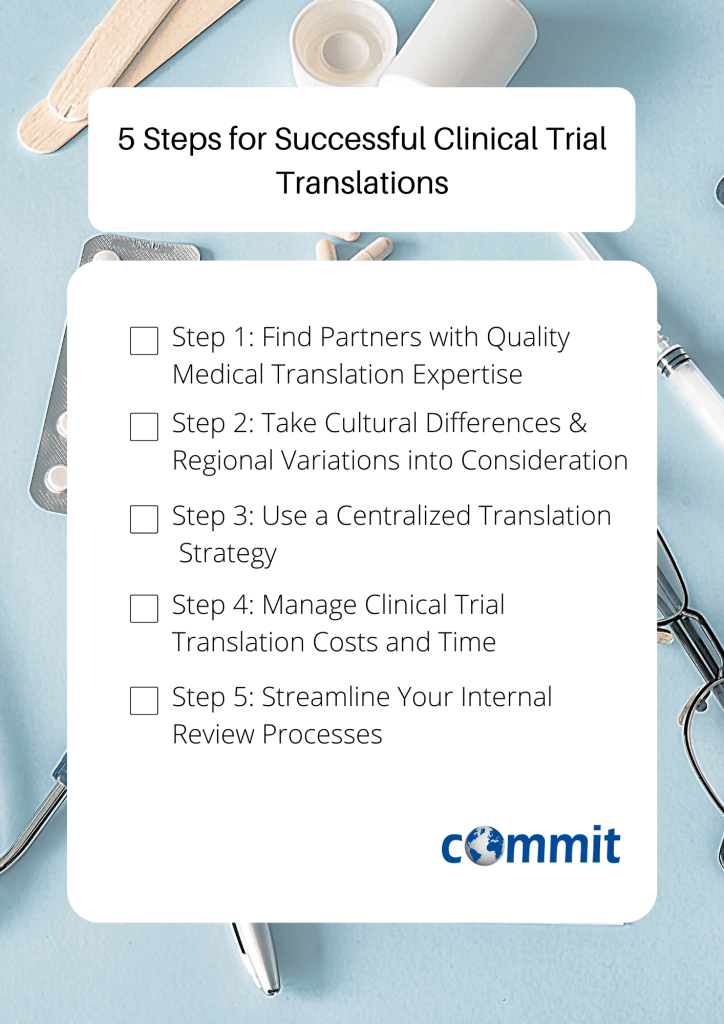|
Listen to Post
|
Listen to this article now:
Accurate clinical trial translations are a critical ingredient in the clinical trial process. Since they report precise data regarding side effects, success rates, dosages, testing procedures, and more, getting the language as precisely as the data has been gathered is essential to success.
In years gone by, clinical trials took place in the country where the new treatments originated. Today, that’s not always the case, as Matthias Steiert et al. point out.
Why Accurate Translations Are Critical to a Clinical Trial’s Success
International Clinical Trials Now the Norm
Recent statistics show that 51 percent of the world’s clinical trials occur outside the United States, while 33 percent occur within the US. Five percent of them occur in both the US and outside the country, and 12 percent were not provided.
It gets even more complex when you look at the international makeup of researchers conducting clinical trials.
Take, for example, the Pfizer COVID-19 vaccine. Invented by a German-Turkish couple, the vaccine underwent initial trials in Germany, but it also faced clinical trials in the US and other countries. The nuanced differences between the inventors’ native language and that of their new country are staggering, let alone between those two languages and English and other languages.
Yet, the clinical trials’ translations must be spot-on accurate to ensure success. An inaccurate translation, as Steiert et al. point out, can result in patient non-compliance, physician error, and most importantly, “physical or emotional damage, misconduct of the experiment,” and a waste of the developers’ investment of money and time.
Countries’ Clinical Trial Translations Requirements Vary Widely
Differences in researchers’ and recipients’ languages aren’t the only challenges facing pharmaceutical and medical device companies involved in clinical trials.
Unfortunately, not all countries require translations into their native language. While both the European Union and the US have made strides in this area, many countries require only English-language translations since they assume that medical professionals will likely be proficient in English.

The EU
The EU, for example, has recently introduced stricter translation standards for all documentation and communication regarding medical devices, including mHealth apps, in its new Medical Device Regulations (EU MDR). Clinical trial translations for new medical devices will also fall under its jurisdiction.
The EU MDR requires that documentation involving medical devices must be translated into all 24 EU languages. However, Slovenia and Croatia will also accept English translations.
Canada and the US
On the other side of the globe, Canada requires that only labels and informed consent forms be in both its official languages, English and French. However, with French speakers making up 22.8 percent of its population, clear communication could challenge both patients and physicians without translating all documentation into both languages.
The US only requires that clinical trial translations documentation be in English, even though people of Hispanic descent comprise 18.4 percent of its population. With nine states and Puerto Rico’s Hispanic populations well over that number, it would be prudent for pharmaceutical and medical device companies to include Spanish in clinical trial documentation headed for the US.
It’s Not Only the Legal Aspects
With the highly technical language that clinical trials must use, leaving any vagueness in nuance between English and the native language of countries that only require English translations is a dangerous proposition.
Although your company might have covered the legal angle with an English-language translation, the public relations fallout from “lost in translation” moments could be momentous.
If physicians whose native language isn’t English misinterpret the language in your clinical trial report, it won’t be them whose reputations will suffer – it will be your company and its new product. Don’t be that company. Instead, follow these five essential steps for clinical trial translation success.
Follow These Steps for Successful Clinical Trial Translations
Step 1: Find Partners with Quality Medical Translation Expertise
Having subject matter experts who are native speakers in each country is a game-changer in any industry. With people’s lives at stake, it’s even more essential to cover those two bases. Inaccurate translations can also cause delays in approval, allowing competitors to edge your company out.
Additionally, since your clients and partner research organizations will look for credentials recognized all over the world, insist that any translation company you contract with has pertinent ISO certifications, as does ours.
Step 2: Take Cultural Differences and Regional Variations into Consideration
Within a single language, regional variations occur, such as between Mexican and European Spanish or the unique patois of Quebecois French speakers versus that spoken on the Continent. Using native linguists assures you that your recipients can understand every word.
Along with regional variations, as Steiert et al. show, cultural differences can impact the success of clinical trials. For instance, people from cultures that emphasize compliance, such as Russia and China, tend not to complain about adverse reactions to the medication tested.
With local speakers involved in the translation, they can flag sections of the documentation that might need additional information to assure patients that reporting adverse reactions to the medication or device won’t be perceived as complaints but rather as actual compliance.

Step 3: Use a Centralized Translation Strategy
Using a single language service provider (LSP) that can handle all the languages you need ensures that your translations will be consistent across all languages and cultural differences. And, they can easily provide you with all the translations required to address the needs of patients and doctors in all the cultural and linguistic variations in every country.
Step 4: Manage Clinical Trial Translation Costs and Time
Furthermore, with a single provider, you’ll have centralized storage for all your translations. Instead of re-translating often-used words, phrases, and sentences, you can increase your time to market and ensure translation consistency.
Using a centralized translation memory (TM) also reduces costs. When you have at least part of a new translation already on file, you will save on both money and time, since the linguist won’t have to redo it from scratch. And, you’ll better meet doctors’ and patients’ expectations for fast results.
Step 5: Streamline Your Internal Review Processes
Clinical research trials require complex internal review processes. The review processes are typically performed by internal staff (as an additional task to their existing job responsibilities) and usually take quite a bit of time, causing delays in the completion of the project. However, partnering with a company that has extensive experience in the life sciences field, including pharmaceutical and other clinical trials, you’ll have a team of experts on clinical trial terminology that can also work directly with the reviewers (whether internal or external) to ensure your translations comply with the requested standards and have clear and accurate clinical language.
With the need for clinical trials and accurate documentation never so critical as today, it is essential for pharmaceutical and medical device companies to ensure that their clinical trial translations meet their users’ needs. To learn more about how accurate clinical trial translations can make an impact on your success, get in touch with the Commit Global team today!

Read also:
Informed Consent Translations: The Importance of Understanding
The Importance of Accuracy in Medical Translations – The Case Of Willie Ramirez
Why is language translation so crucial in clinical trials?
Linguistic Validation Services in Life Sciences Localization








